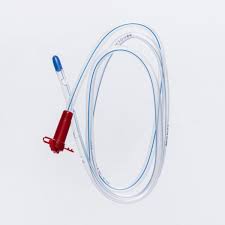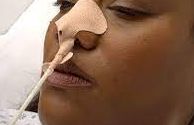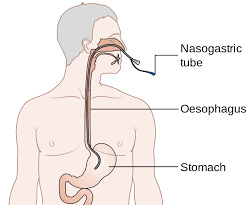
Essential Nasogastric Tube Care: A Step-by-Step Guide
Welcome to our comprehensive guide on Nasogastric Tubes (NG tubes). If you or a loved one is facing the prospect of having a nasogastric tube inserted, this resource is designed to provide valuable insights into the purpose, insertion procedure, and essential care tips for a smoother experience. Understanding NG Tube basics is crucial for patients seeking information and reassurance about this medical intervention

Nasogastric tubes, often referred to as NG tubes, are medical devices that are inserted through the nose and into the stomach for various diagnostic and therapeutic purposes. While they are commonly used in healthcare settings, the idea of having an NG tube can be intimidating for patients. Understanding what it is, why it’s necessary, and how to care for it can alleviate anxiety and ensure a smoother experience.
 What is a Nasogastric Tube?
What is a Nasogastric Tube?
A nasogastric tube is a flexible tube made of either plastic or rubber that is inserted through one of your nostrils, down your throat, and into your stomach. It can be used for a variety of medical purposes.
Why Might You Need a NG Tube?
Nasogastric tubes serve several important purposes:
a. Feeding: One common use of NG tubes is for providing nutrition when a patient is unable to eat or swallow. This can be due to various medical conditions such as surgery, illness, or trauma.
b. Medication Administration: NG tubes are also used to deliver medications, especially when the medication cannot be taken orally or when it needs to be absorbed directly in the stomach. It may also be necessary in cases of gastric obstruction or excessive stomach acid.
c. Stomach Decompression: In cases of gastrointestinal obstruction or surgery, nasogastric tubes can be used to remove excess air and fluids from the stomach to relieve pressure.
d. Diagnostic Testing: Sometimes, an NG tube may be used to collect samples of stomach contents for diagnostic purposes such as pH monitoring or gastric emptying studies, to assess the function of the stomach.
 What to Expect During NG Tube Insertion?
What to Expect During NG Tube Insertion?
The insertion of a tube can be uncomfortable but is typically a quick procedure. It is performed by a healthcare professional. Here’s what you can expect during the procedure:
a. Preparation: The healthcare provider will explain the procedure to you and answer any questions you may have. You will be asked to sit or lie down in a semi sitting position.
b. Numbing: To make the insertion more comfortable, a local anesthetic may be applied to the back of your throat and nasal passages.
c. Tube Insertion: The healthcare provider will gently insert the tube through your nostril, down your throat, and into your stomach. You may experience a gagging sensation, but it’s important to stay still and cooperate with the healthcare team.
d. Confirmation: Once the tube is in place, its correct positioning will be confirmed using an X-ray or by checking the pH level of stomach contents.

How can you care for Your NG Tube?
Proper care of your NG tube is essential to prevent complications and ensure its effectiveness:
a. Securing the Tube: The tube will be secured to your nose and cheek with medical tape or a special adhesive device to prevent accidental removal. Make sure it’s not too tight or too loose to prevent skin irritation.
b. Cleaning: Keep the area around the tube clean and dry. Follow the healthcare provider’s instructions for cleaning and securing the tube. You may be instructed to clean it with warm water and mild soap.
c. Medication and Feeding: Your healthcare provider will instruct you on how to flush the tube with water before and after medication or feeding. Follow the healthcare provider’s instructions for administering medications or feeding through the tube.
d. Monitoring: Pay attention to any signs of irritation, infection, or dislodgment of the tube. Report any concerns to your healthcare team promptly.
What Are The Potential Complications?
While NG tubes are generally safe, there are some potential complications to be aware of, including:
a. Discomfort: You may experience a sore throat or discomfort in your nose and throat, which is usually temporary.
b. Infection: Infections around the insertion site can occur if proper hygiene is not maintained.
c. Tube Dislodgment: Accidental removal or displacement of the tube can happen. If this occurs, contact your healthcare provider.
d. Nasal Irritation: Prolonged use of NG tubes can cause nasal irritation and erosion of the nasal mucosa.
Removal of the NG Tube
Once you no longer require the NG tube, it will be removed by a healthcare professional. Removal is typically a quick and straightforward process.
Nasogastric tubes are valuable medical tools that can aid in various aspects of patient care. An NG tube may seem daunting, but understanding its purpose and how to care for it is not only crucial for both your comfort and well-being but can help you feel more at ease. Remember that your healthcare team is there to guide you through the process and provide support. If you have any questions or concerns about your NG tube, don’t hesitate to reach out to healthcare provider for clarification and guidance. Your active involvement in your care will help ensure a smooth recovery process.
Disclaimer: The information provided in this content is for general informational purposes only. It is not intended as medical or healthcare advice, diagnosis, or treatment. Always seek the advice of a qualified healthcare professional with any questions you may have regarding a medical condition or healthcare decisions.
















